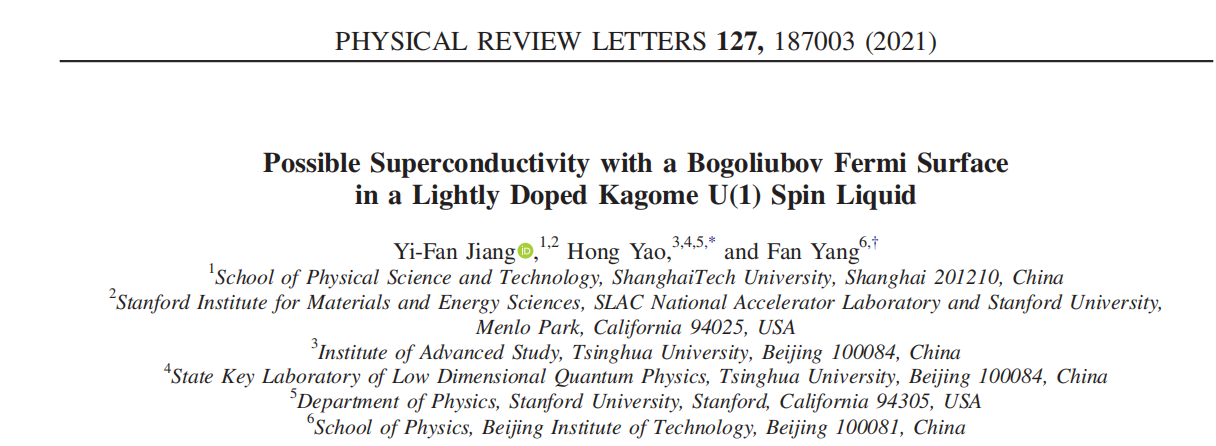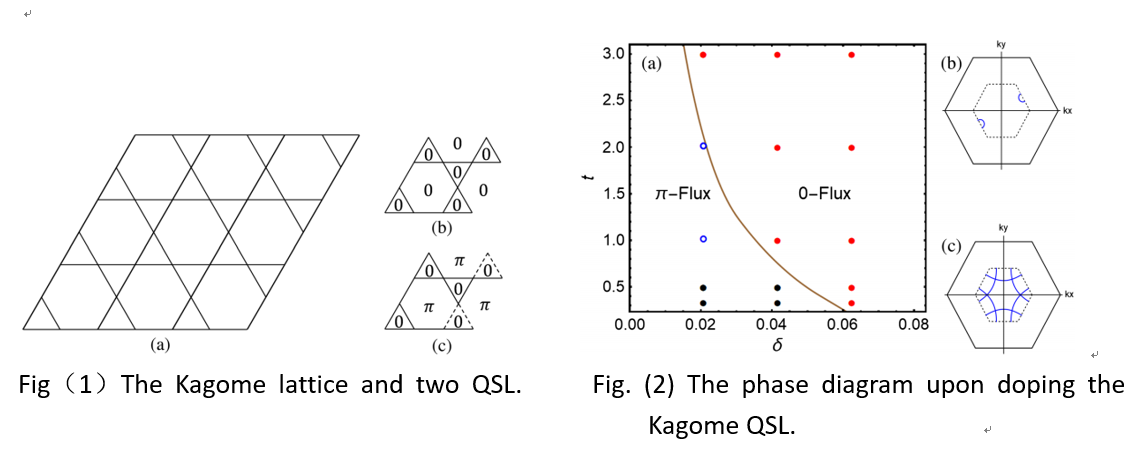Beijing Institute of Technology Has Made Important Progress on the Pairing Mechanism of High-Temperature Superconductivity
来源: 作者: 发布时间:2022-10-13
Recently, Prof. Fan Yang from School of Physics, Beijing Institute of Technology, together with his collaborators, has made important progress on the pairing mechanism of high-temperature superconductivity (SC). Their results “Possible Superconductivity with a Bogoliubov Fermi Surface in a Lightly Doped Kagome U(1) Spin Liquid” has been published in Phys. Rev. Lett.
The Nobel laureates P. W. Anderson, who was one of the pioneers of condensed-matter physics, has proposed a very famous theory: when a quantum spin liquid (QSL) is doped, it will turn into an unconventional superconductor. The QSL states belong to a special type of spin states, which do not enter the magnetic-ordered state or other symmetry-breaking states even at zero temperature, and hence go beyond Landau’s general framework of phases. Anderson’s theory points out that in these states, the electrons with opposite spins have already paired. However, due to the lack of free charge carrier, the system is Mott insulator. In such a condition, any doping will lead to SC. Although Anderson’s theory is deep and reasonable, it has not been realized in any realistic material or simple model system. In 1973 and 1987, Anderson proposed QSL ground states of the triangle- and square-lattice Heisenberg models respectively, with the latter leading to high-temperature SC in the cuprates. Later, these two model systems are judged to host magnetic ordered ground states, so that cannot realize QSL. However, a new spin system, i.e. ZnCu3(OH)6Cl2, emerges in recent years which has attracted much attention. This system host a Kagome lattice structure depicted in Fig. (1). Various experiments suggest a QSL phase for this system. In the theoretical aspect, the numerical results from various research groups also support a QSL ground state, among which the projected -flux state shown in Fig. (1) is most possible. However, no systematic research has been performed on what type of SC would be formed after this spin system is doped.
To explore the emergent quantum state upon the doping of the Kagome QSL, Fan Yang and his collaborators adopted the variational Monte-Carlo (VMC) approach to study the corresponding t-J model. In this variational study, a new trial wave function was adopted: the Gutzwiller-projected mean-field state obtained at half filling is adopted at finite doping, but followed by an SU(2) gauge rotation, with the gauge-rotation angles serving as the variational parameters to minimize the energy. The phase diagram obtained is shown in Fig. (2), where the low- and high- doping regimes are occupied by the SU(2)- gauge rotated - and 0- flux states. These states break the lattice translational symmetry, the time-reversal and inversion symmetries. Furthermore, the U(1)-gauge symmetry breaking induced by the gauge rotation leads to SC. It’s interesting that in this superconducting state, the Bogoliubov quasi particles possess Fermi surface, therefore the elementary excitations in this superconducting state is similar with standard Fermi liquid, reflected in such aspects as the specific heat, the NMR, the STM and so on. However, this system host the properties of zero resistivity and Meissner effect, which is distinguished from the Fermi liquid. Such novel superconducting states originates from the inter-band pairing caused by strong correlation. This result also suggests that for a large type of U(1) QSL states, the doping would generally lead to SC with Bogoliubov FS. The credit of this work lies in two aspects, on the one hand it has found a realization for Anderson’s theory, on the other hand it leads to a novel superconducting state.

Fig(1)The Kagome lattice and two QSL. Fig. (2) The phase diagram upon doping the Kagome QSL.
This work was published in Phys. Rev. Lett. 127,187003 (2021)。 The associate professor Yifan Jiang from Shanghai Science and Technology University is the first author of the paper. Prof. Fan Yang and Prof. Hong Yao from IASTU serve as the co-corresponding authors. This work is supported by the NSFC.
Link of the paper: DOI: 10.1103/PhysRevLett.127.187003
Introduction of the author:
Fan Yang joined the physics department of Beijing Institute of Technology in 2004. His research area is theoretical strongly-correlated electronic systems and superconductivity. He has made a series of research results on the high-temperature cuprates superconductors, the quantum spin liquid, the iron-based superconductivity, the correlated electronic states in the magic angle twisted bilayer graphene and the superconductivities on the quasi crystal and so on. He has undertaken five NSFC fundings, and was bestowed the “Excellent person for the new century”. He has published over 50 papers including seven ones in Phys. Rev. Lett., among which in five papers, he is the first or corresponding author. The total citation of his paper is over 1000.




